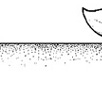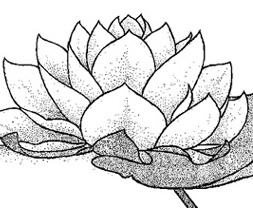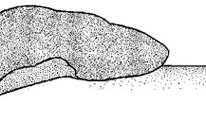Home Growing
up a Lotus Master
Gudo Papers Teachings Pali
Canon
Mahayana Sutras Humour History Gallery Contact Links
|
Some Southern Zen Growing
up a Lotus
|
|||||||||||||||||||||||||||||||||||
|
See also Introduction: my personal approach |
|||||||||||||||||||||||||||||||||||
|
   How to Grow a Lotus Sooner or later, it can happen to even the most experienced meditator. You've been sitting crossed-legged for years without any problem, and one day, in the middle of a retreat, you develop the most excruciating pain in one of your knees. You haven't been paying enough attention to stretching your hips, and now your poor knees are starting to suffer. Or perhaps you've been thinking of meditating but find that legs simply won't hold into one of those pretzel-like poses. So you're holding back--interested, but unwilling to put yourself through the excruciating pain. Well, join the club--you're just one of millions of westerners who find Padmasana (Lotus Position) and the other cross-legged postures among the most difficult yoga poses to master. Unlike our Indian friends, we did not grow up sitting on the floor, and consequently our hips have developed an adaptation to our sitting on chairs. Throughout childhood, and especially in the typical adult sedentary job, prolonged sitting on chairs has caused a shortening of the very muscles and ligaments that need to be flexible for Padmasana. To make matters worse, the hip is an deep ball-and-socket joint with some of the strongest ligaments in the body, which prevent the femur from becoming disassociated. With this stability comes a subsequent lack of mobility. To change the structure of the hip takes careful, persistent, practice over a long period of time. But take heart--the Divine is infinitely patient and will not exclude you from a happy rebirth if you do not attain Padmasana in this lifetime! Never force yourself into Padmasana or the other cross--legged positions. The knee joint is particularly susceptible to injury for a number of reason. First, the knee is one of the most primitive joints in the body and is much weaker than the hip. If you have very tight hips, you may over-stretch the knees without increasing you hip flexibility one iota. The hips, not the knees must be flexible for lotus pose. Second, when fully extended, the knee joint will not rotate. When the joint is bent, however, a slight rotation does come into play, and this rotation can be injurious to the knee, damaging the ligaments, cartilage, and meniscus. The knee is an unforgiving joint; once injure, it may never be the same again. Therefore, if you feel a sharp pain in the knee, adjust your position or seek the help of a competent teacher. The following series will help you prepare for Padmasana. The stretches are best done after practicing standing poses when the body is warmed up. Those who are tight should practice in the afternoon, when they have more flexibility. Begin by holding each position one minute, increasing to five minutes as the poses come with more ease. Use a watch or timer for consistency, as one minute can rapidly become fifteen seconds in the more intense stretches. Those with knee or ankle injuries should be especially cautious here. If your discomfort cannot be alleviated by adjusting your position, you would be wise to seek the help on an experienced teacher. You might also try alternating sitting positions, such as Virasana (Hero Pose) or Siddhasana (Sage Pose) with the buttocks elevated on a firm blanket. These poses are excellent for both meditation and pranayama practice. In all stretches, use deep abdominal breathing to open the body from inside. Rather than "trying" to relax by pressing the muscles into the stretch, take your breath deep into the center of the pelvis. With each inhalation feel the hips expand, and with each exhalation allow the muscles to slip away from the bones. [This being said, this is an image: from the anatomical point of view, muscles don't slip away from the bones] Working gently in this way, the body will welcome the pose and progress quickly toward achievement of Padmasana.
|
|||||||||||||||||||||||||||||||||||
|
Figure 1.
Figure
2.
Figure
3.
Sit in Virasana
(hero posture) with the knees in line with the hips.
Drawing the center of the pelvis into the center of the thighs, recline
on your back onto the elbows. Depending on your flexibility, either
support your back with a bolster or recline on the floor with the arms
over the head. Do not attempt to recline if the knees splay out or come
off the floor.
Figure
4.
Figure
5
Obviously, few
people succeed in
doing this right from the start. Thus, and especially for men, I advise
that you fold the knee so as to
better seize the foot, rather than holding the leg straight and be
content of pullingit, in an attempt to seize the calf. The articulation
shall progressively stretch.
Figure
6.
Figure
7.
Figure
8.
Figure
9.
Same indication as
to figure 5. Fold the knee so as to better seize the
foot, rather than holding the leg straight and be content of pulling in
an attempt to seize the calf. The articulation shall progressively
stretch.
Figure
10
Figure
11.
Figure
12.
Same indication as
to figure 5. Although it may not be so simple as in
figure 9, try to fold the knee so as to better seize the foot, rather
than holding the leg straight and be content of pulling in an attempt
to seize the calf. Otherwise, do as you can. The articulation shall
progressively stretch.
Figure
13.
When bringing the
foot onto the top of the thigh for Padmasana, hold at
the shin and ankle, not at the top of the foot. Keep the ankle flexed
(figure A) to prevent supination, or sickling (figure B). Once the
ankle is resting on the thigh, you may relax the foot. Sickling can
pull on the ligaments and cartilage of the lateral knee, causing
potential injury to these delicate structures. And, any other way,
DON'T OVERSTRETCH. Whatever you may be told, change position, rather
than bear the pain. This is no masochistic contest.
Figure 14.
Figure
15.
Figure
16.
In practicing Padmasana, remember that the body and the asana must meet on their own terms in their own time. If you inflict the asana on the body, you may set up a dichotomous relationship between what you think the body "should" be and what the body is. The body then becomes an enemy to be conquered rather than a companion on the journey. By giving up your preconceived idea and images of how far you think you should go, you free yourself to explore the asana in the present moment, just as a lover might give full attention to his beloved. Practicing with true affection, let the pose become a journey rather than a destination. Then even a difficult posture like Padmasana will become enjoyable. (return to the top of the page)
Donna Farhi
Schuster is a certified Iyengar
yoga teacher, and educational bodywork therapist practicing in the San
Francisco Bay Area.
Following : Zazen
|
|||||||||||||||||||||||||||||||||||
 Version française
Version française
















